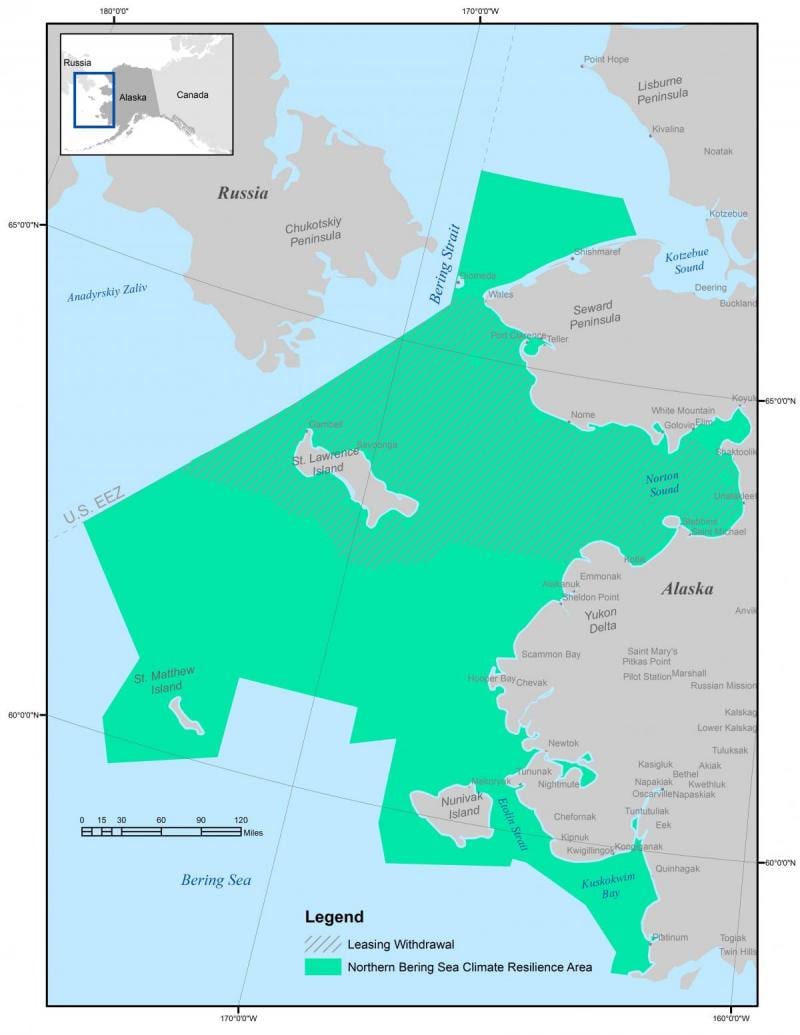Northern Bering Sea Climate Resilience Area

The Northern Bering Sea and Bering Strait region in Alaska is one of the most historically, environmentally and culturally significant places on our planet. It is home to one of the largest marine mammal migrations in the world, as millions of animals, including beluga and bowhead whales, walruses, and seals, travel through the funnel of the Bering Strait every year on their way to and from feeding and breeding grounds in the Arctic. Millions of seabirds, from multiple continents, make their way to the Arctic each spring to take advantage of the seasonal burst of productivity which also supports invertebrates and fish.
This katawhsaqa, or “pouring out” in the St. Lawrence Island Yupik language, also makes the northern Bering Sea and Bering Strait region critically important to culture and food security of the Yup’ik, Cup’ik and Inupiaq people who have relied on these rich resources for millennia. The people here live a traditional subsistence way of life that is inextricably tied to the health of the marine ecosystem.
Climate change and the rapid depletion of sea ice in the Arctic Ocean are altering the ecology of the area, as the ice melts earlier in the year and freezes later. This loss of sea ice threatens hunting and fishing opportunities and overall food security for the Alaska Native tribes who depend on the abundant resources of the region. At the same time, the region which is ice-free for longer periods than ever, is increasingly vulnerable to threats from increased shipping, expanded industrial fisheries, and offshore oil and gas development. These stresses, combined with the existing threats from climate change, place the people, the animals, and this unique ecosystem at grave risk.

On his first day in office in January of 2021, President Biden issued an Executive Order that restored the Northern Bering Sea Climate Research Area and reinstated Preisdent Obama’s Executive Order outlined below.
In December 2016, President Obama issued an Executive Order designating the Northern Bering Sea Climate Resilience Area in Alaska. Kawerak, Inc., the Bering Sea Elders Group, and the Association of Village Council Presidents, which together represent more than 70 federally recognized tribes, were instrumental in achieving the historic designation. The Executive Order facilitates inclusive, comprehensive management by establishing the Northern Bering Sea Climate Resilience Area Task Force within the White House’s Arctic Executive Steering Committee and by creating a Northern Bering Sea Intergovernmental Tribal Advisory Council that will improve consultation with tribes in the region. It also maintains the current prohibition on bottom trawling, requires additional steps to protect important places from the impacts associated with shipping, and prohibits oil, gas and mineral leasing in certain areas.

- President Obama’s Executive Order
- Oceana Blog: Historic Protections for Alaska’s Northern Bering Sea and Bering Strait
- Kawerak, Inc. Resolution
- Bering Sea Elders Group Resolution
- Association of Village Council Presidents Resolution

The Bering Strait Marine Life and Subsistence Data Synthesis depicts areas of importance and high abundance for marine species, such as ice seals, walrus, polar bears and whales, as well as other marine ecosystem components like benthic habitat and sea ice. This synthesis uses both western science and Indigenous Knowledge to create a synthesis that decision makers can use to help protect valuable and vulnerable marine areas from human threats such as shipping, and large-scale commercial fishing. The synthesis is the result of a multi-year collaboration between Kawerak, Inc. and Oceana.
- Kawerak, Inc. and Oceana’s Bering Strait Marine Life and Subsistence Use Data Synthesis



